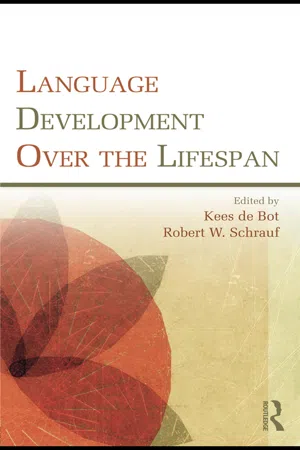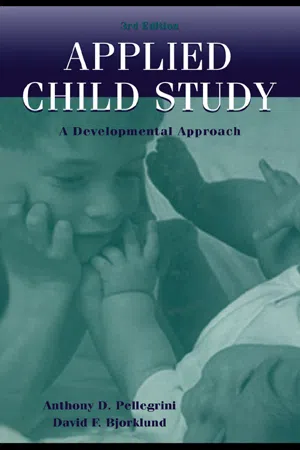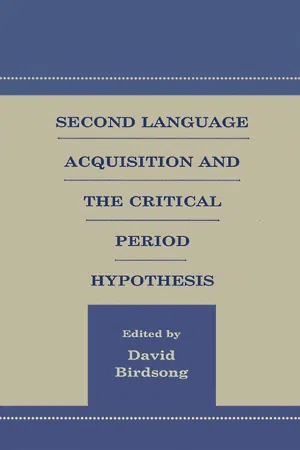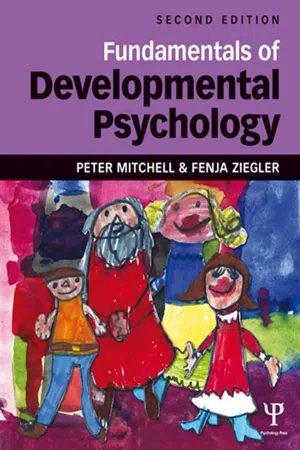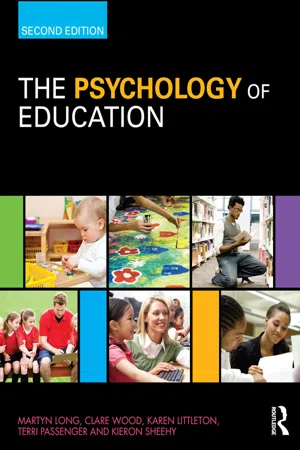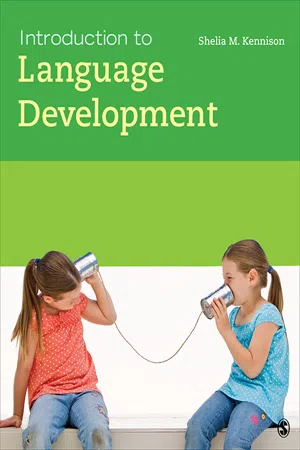Languages & Linguistics
Language and Age
Language and age refers to the relationship between a person's age and their language use and development. It encompasses how language skills evolve over a person's lifespan, including the acquisition of language in childhood, changes in language use and proficiency as individuals age, and the impact of aging on language processing and production. This area of study explores the dynamic nature of language across different stages of life.
Written by Perlego with AI-assistance
Related key terms
9 Key excerpts on "Language and Age"
- eBook - ePub
- Kees de Bot, Robert W. Schrauf(Authors)
- 2010(Publication Date)
- Routledge(Publisher)
162). However, as the contributions to the present volume show, this not really the case. Research in language and aging has boomed over the last decade. Klein’s “Language acquisition at different ages” in the edited volume The lifespan development of individuals (Magnusson, 1996) focused on the comparison between first language development in children and second language development in adults, in particular migrants in Europe, but paid little attention to the large body of research on language in the elderly. His work shows that “the age-factor” has been studied intensively in second language acquisition research. The main question concerned (then and now) whether and to what extent second language learners can reach a native level of proficiency (see Birdsong 2006 for a recent in-depth overview). Here “age” is basically limited to the time from birth till puberty. The same picture emerges in handbooks on language development, where the focus is on the early stages of development. This is logical. The foundations of language are laid in those early years. However, there seems to be an inverse relation between the age of the child and the number of studies devoted to language development at that age. Fewer studies address older children. After the development of oral skills, scientific interest seems to shift to literacy (the development of reading and writing skills) and developmental disorders such as dyslexia. Berman’s (2004) edited volume Language development across childhood and adolescence is unusual in terms of the age range studied; nevertheless, there are no studies on children older than 16. Surprisingly, there is hardly any research on language development in the age range from 18 till 55 - eBook - ePub
- Allan Bell(Author)
- 2013(Publication Date)
- Wiley-Blackwell(Publisher)
Together with gender, age is the most fundamental social factor structuring any study of language variation. Yet Coupland’s claim that ‘age is sociolinguistics’ under-developed social dimension’ (2001a: 185) still holds by comparison with class, ethnicity and gender, the other players in the usual quartet of social variables. Like gender and ethnicity, age cannot be crudely equated with physical/biological characteristics, although sociolinguistics has been slow to reflect this. Chambers, for example, writes: ‘Our ages remain fixed … age plays an almost autocratic role in our social lives’ (2009: 159). There is no denying the physical dimension, most obvious at the youngest and oldest stages of life, with initial growth from infant to adult and eventual decline from health to death. But age is not controlled by chronological time, it has social and psychological dimensions. It is structured and conceived differently by different cultures and different individuals.Age interacts with other social characteristics – with gender in several examples in the previous chapter: the use of ING in a college fraternity, African American youth vernacular, the shift from women’s to men’s language by Yanyuwa boys. There can be strong and specific linguistic opportunities or limitations for particular age × gender groups in a society, for example for young females versus males (Exercise 8.1 ). Such sociolinguistic expectations usually police young women’s usage of non-standard or taboo language. Age also interacts with ethnicity or class. Very group-specific class × age × ethnicity × gender codes are well known, as shown in Chapter 6’s case study of the gíria ‘slang’ spoken by poor young black men in Rio de Janiero.Exercise 8.1 Youth slang in the United StatesCorpus linguistics is an approach on the edge of sociolinguistics which collects and analyses very large samples or ‘corpora’ (often millions of words) of spoken or written language representing, for example, the state of British English in a given period. The amount of data means that social or contextual information is often limited, and analyses focus on features that can be computer-searched (Biber, Conrad and Reppen 1998). - eBook - ePub
Applied Child Study
A Developmental Approach
- Anthony D. Pellegrini, David F. Bjorklund(Authors)
- 1998(Publication Date)
- Psychology Press(Publisher)
We have seen that children learn a new language most effectively when they have the desire to communicate with others and become part of the culture represented by the new language. Children are viewed as active learners who are motivated to learn new language forms by a desire to communicate ideas that they cannot express to others with their current linguistic repertoire. Fillmore’s (1979) work also shows that learning a second language is not just a “linguistic” problem, but is affected by a child’s cognitive and social skills and the presence of a supportive social environment of peers. Although the effect of the interaction of social, motivational, and linguistic factors is most obvious in the learning of a second language, it is also true for the acquisition of a child’s first language (L.Bloom, 1997). Language is acquired in a social context, be it home or school, or with parents or with peers, and we must be mindful of these social and emotional factors when trying to explain language development.The Role of Age in Learning a Second Language
Our earlier discussion concerned young children learning a second language. Would learning be easier if children were older or younger than the 5- to 7-year olds studied by Fillmore (1979)? The answer is obvious here: Younger is better when it comes to learning a second language. People who learn a second language only as adults rarely become proficient in that language. This is seen both in phonology (“foreign” accents) and syntax.It is easy to spot almost anyone who learned a second language as an adult. Even if they are articulate, well-educated, and have an impressive vocabulary, they almost always have a noticeable accent. Research has confirmed this. Oyama (1976) studied Italian immigrants in the United States and assessed their accents as a function of (a) their age of arrival to the United States, and (b) how long they had resided in the United States. Only the first factor, age of arrival, and thus age at which they were first exposed to English, predicted the degree of their accents.Perhaps more subtle is syntax. Presumably, people who live in a country for many years will eventually master “like a native” the syntax of a language, even if they retain an accent. This was tested in research by J.S.Johnson and Newport (1989), who examined second-language learning as a function of age. They tested 46 native Chinese or Korean speakers who had emigrated to the United States and learned English as a second language. The age of people at time of arrival in the United States ranged from 3 to 39 years, and they had lived in the United States between 3 and 26 years when they were tested. - David Birdsong(Author)
- 1999(Publication Date)
- Routledge(Publisher)
Our approach to evaluating the argument for a critical period is to show that age intervenes in the effect that linguistic and cognitive factors have on success in second language acquisition. Therefore, correlations between age and success are spurious because the relation is actually reflecting the effects of these linguistic and cognitive factors. Statistically, this argument could be demonstrated by partialling age out of the equation and then studying the relation between these linguistic and cognitive factors in the absence of age. If our explanation is correct, then the partial correlations between linguistic and cognitive sources of variance and proficiency should remain significant when age is not included in the equation. Alternatively, if it could be shown that linguistic or cognitive factors (or social, although we do not discuss these) were capable of producing patterns of results that are sometimes attributed to age differences, then the role of age in explaining these effects would need to be reconsidered. Our approach, however, is to offer data that challenge the interpretation that the effects are caused by age by identifying areas in which empirical results contradict predictions from the critical period hypothesis.The debate over the critical period hypothesis embodies some of the most basic questions about second language acquisition, and indeed, language acquisition in general. These questions permeate the foundations of several disciplines, such as linguistics, cognitive psychology, and neurolinguistics. Is language learning governed by environmental conditions or by an internal bioprogram? Do languages reside in independently constructed mental representations or are they mutually available in processing? Is transfer a legitimate process in language learning or an unwanted symptom of the improper separation of distinct languages? To some extent, the answers to these and other fundamental questions in human language learning rest partly in the role that age plays in acquiring languages. If there is a critical period for second language acquisition, then logically there is also one for first language acquisition, and the answers to questions about language processing take a clear direction. One must be prudent, therefore, in accepting the hypothesis for a critical period in second language acquisition. Methodologically, one must begin with the null hypothesis that no such limitation exists and produce reasons why this hypothesis should be rejected.- eBook - ePub
The Social Construction of Age
Adult Foreign Language Learners
- Patricia Andrew(Author)
- 2012(Publication Date)
- Multilingual Matters(Publisher)
5 prevalent in contemporary Western culture, but one that thus far is not sustained by solid evidence.A larger problem with the CPH studies is that age is invariably treated in chronological terms. Even those researchers who do not fully accept the biological determinism of the CPH and ascribe age-related differences to other factors connect them with chronological age. Such an essentialist notion of age can lead to a simplistic and unquestioned mode of categorizing people into groups by age-in-years or, more broadly, by life stages, that does not always dovetail with lived experience. Chronological age is not a reliable indicator of where a person is in the life course for, as Eckert points out, ‘social and biological development do not move in lock step with chronological age, or with each other’ (Eckert, 1997a: 154–155). Moreover, life stages, such as childhood, adolescence and middle age, are identified and defined differently from one culture to the next and from one moment in history to another. This explains in part why age can never be fully isolated from other social factors, such as gender, social class and ethnicity.This stance is also consistent with the sociocultural perspective on SLA, one which gives greater prominence to social reality, in contrast to the mainstream cognitive strand of SLA, which has tended to neglect the social aspects of learning by focusing primarily on decontextualized cognitive processes. The principal thrust of research in the cognitive tradition has been on determining how individual learner factors, such as age, account for differential success among learners. The emphasis for the most part has been on universal properties of language and acquisition, on the formal aspects of language and on mental processes in the individual. The social side of language learning has largely been skirted by researchers adopting a psycholinguistic orientation to SLA. This is evident in the body of CPH research reviewed here (see ‘language focus’ in Table 1.1 - eBook - ePub
- Peter Mitchell, Fenja Ziegler(Authors)
- 2013(Publication Date)
- Psychology Press(Publisher)
12 DOI: 10.4324/9780203736357-12Contents
Introduction The components of language A description of language development Vocabulary development Theories of language acquisition Chomsky’s theory of innate language development A second look at the environment SummaryLanguage development 12
Chapter Aims- To introduce the properties of language.
- To introduce the components of language.
- To chart the path of language development.
- To contrast different theories of language acquisition.
Introduction
Language has been described as the jewel in the crown of cognition (Pinker, 1994 ). Indeed, our ability to use language is often cited as something that sets us apart from other animals. However, on a fundamental level language is something we use to communicate, and there are many other living things that communicate with each other. For example, bees convey the location of rich sources of pollen to other inhabitants of their hive with an elaborate “dance.” Is this dance something we should call language? Human language is similar to bee dancing in that both are tools of communication, but in other respects they are very different. Bee dancing is not a language, and it is better to reserve the term for the system of communication used by humans. The reason for this will become clear when we take a look at what language is and how children learn it.None of us can remember much about our first attempts to acquire a mother tongue. However, many of us do have the experience of trying to learn a second language, and that gives insight into the complexity of the process. It is sometimes said that the easiest way to acquire a second language is to pick up an extensive vocabulary - eBook - ePub
Beyond Grammar
Language, Power, and the Classroom: Resources for Teachers
- Mary R. Harmon, Marilyn J. Wilson(Authors)
- 2012(Publication Date)
- Routledge(Publisher)
Because these subsystems of language function only in social contexts, the sociolinguistic dimensions of language study become central to our analysis of language. For years linguists approached the study of language objectively and with critical distance, describing but not commenting on the social ramifications of its use. Currently, however, applied linguistics has taken a critical turn, focusing not just on the “object” but on the social and cultural framework of language, that has deepened our understanding of it. Decontextualized language study is less messy, but it’s also irrelevant. People always speak within specific cultural contexts that relate their choices and intentions to issues of politics and power.Language AcquisitionHow do children acquire language so effortlessly? How do they do it on their own, without a grammar book or an English teacher to teach them? Linguists agree that language is biologically determined and that its acquisition is an instinctive, natural process that is inevitable and certain, given normal intelligence and exposure to language. Steven Pinker says,Language is not a cultural artifact that we learn the way we learn to tell time or how the federal government works. Instead, it is a distinct piece of the biological makeup of our brains. Language is a complex, specialized skill, which develops in the child spontaneously, without conscious effort or formal instruction, is deployed without awareness of its underlying logic, is qualitatively the same in every individual, and is distinct from more general abilities to process information or behave intelligently. (18)Although the degree to which language is biologically determined is vigorously argued, every linguist acknowledges the basic biological predisposition for language. Some linguists liken the process to the germination of a seed. When the conditions are right—the presence of sufficient sunlight, moisture, fertile soil—the genetic code in the seed is activated, and it grows and develops. When the conditions are right for language acquisition—when the child is in the presence of human language and is expected to be a participant—the language acquisition device is activated, and language develops. - eBook - ePub
- Martyn Long, Clare Wood, Karen Littleton, Terri Passenger, Kieron Sheehy(Authors)
- 2010(Publication Date)
- Routledge(Publisher)
The development of the sound system is completed during the early school years. Throughout education, language progress is subsequently most evident in the range and use of verbal concepts. Progress largely depends on experiencing new language in meaningful contexts, and important sources are formal education, conversations, reading and watching television. The majority of the basic structures of language are present by four years of age, although the more complex forms take a long time to develop. Establishing these seems to depend on experiencing language in meaningful situations, and developing and modifying hypotheses about the way in which different forms are constructed and used.Language and thought appear to be closely related, although competence with language structures is probably an independent ability. Even though it has been argued that the development of language depends upon existing cognitive abilities, it now seems more likely that thought and language combine at an early age and then take separate, more specialised forms when children become older. This seems to happen within a context of shared social meanings and shows that language-based support can facilitate cognitive development.There is some evidence that language forms can affect thinking processes. Although it was once believed that language had a strong deterministic effect, it now seems more likely that it merely directs attention and ways of thinking. In doing so, it can sometimes limit our ability to consider alternative approaches and solutions to problems. Different forms of language are characteristic of certain social and cultural groupings. The language forms used by some groups can probably result in a certain impoverishment, although some language forms are more like dialects, which are functional within their own cultural context but may be less widely understood than standard forms of the language.It is rarely possible for education to provide the highly effective, closely monitored and directed language experiences that are possible in the home. Language development in school probably depends on participation in meaningful language-based curriculum experiences, rather than specific instruction. Teaching grammar in isolation is unlikely to be useful unless the emphasis is on its use to communicate meaning. The learning of a second language appears to take place most readily in situations that emphasise its functional usage. Internal language can be a very effective way of developing self-regulation of behaviour. - eBook - ePub
- Shelia M. Kennison(Author)
- 2013(Publication Date)
- SAGE Publications, Inc(Publisher)
As you begin your study of language development, you may find the topic to be unexpectedly complex. To understand language development, one must not only understand the basic aspects of human language that are learned and how knowledge of language is stored in memory but also appreciate the changes that occur throughout human development that might influence how language is learned and processed. The empirical studies that have been conducted to shed light on how language development occurs rely on increasingly technical methodologies. The ways in which researchers make inferences about what infants know and do not know may be difficult to grasp initially. As you become more familiar with the strategies that researchers use to test hypotheses about language development, you may come to believe, as I do, that although language development is a challenging topic to study, it is an important one that has relevance in all of our lives.Table 1.1 Timeline of Language Milestones From Birth to Forty-Eight MonthsUnderstanding the Range of Human LanguagesSource:Adapted from Brown (1973).An important question in the study of language development is whether language development occurs the same way regardless of the language that is being acquired. Some might assume that because there are big differences across the world’s languages, the process of acquiring each language would differ as well. A first step in understanding how differences across languages may be related to how language is acquired is learning more about the basic differences that exist across languages. Today, there are only about 6,000 languages still spoken. Many of these languages are spoken by millions of speakers. The top 10 most widely spoken languages in the world are displayed in Table 1.2 .Of the approximately 6,000 languages that exist in the world today, quite a few are on the verge of extinction with very few speakers. Table 1.3
Learn about this page
Index pages curate the most relevant extracts from our library of academic textbooks. They’ve been created using an in-house natural language model (NLM), each adding context and meaning to key research topics.
